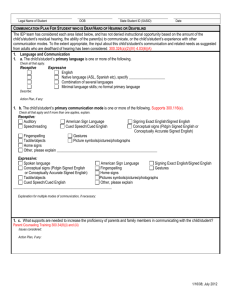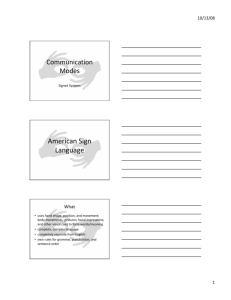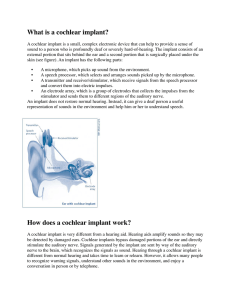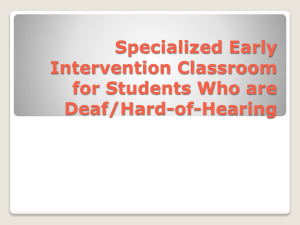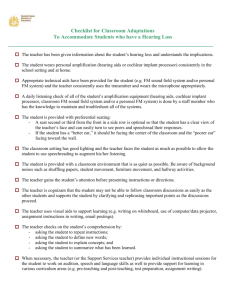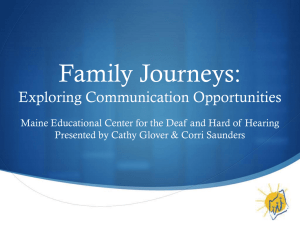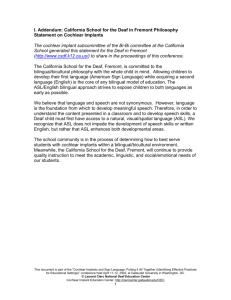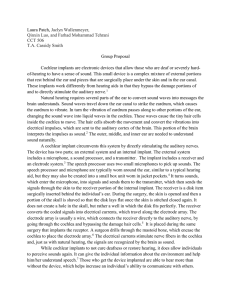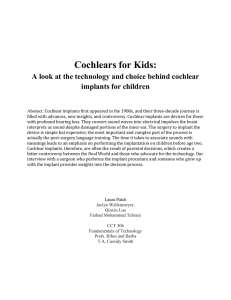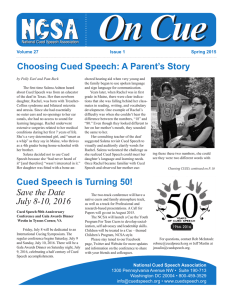Benefits of Culturally and Linguistically Diverse Classrooms
advertisement
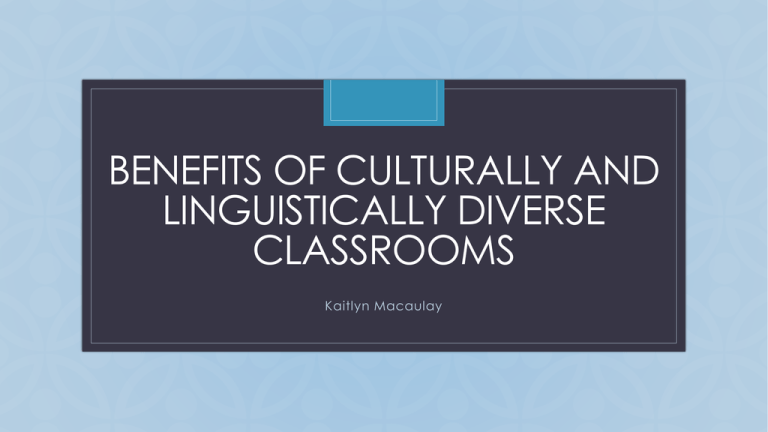
BENEFITS OF CULTURALLY AND LINGUISTICALLY DIVERSE CLASSROOMS C Kaitlyn Macaulay Background Information • Student one is a five year old boy in Kindergarten. He was born Deaf but recently received a cochlear implant for the right ear. At home he uses American Sign Language and occasionally Cued Speech. At school he uses English and Cued Speech. Student one lives with his mother who is also Deaf and his little sister who is hearing. Student one’s family would be classified as low socioeconomic status since se receives free/reduced lunch at school and brings food home daily. Academic Challenges • Everything is based on hearing and speech and less on visual communication • Reading and sight words • He cant hear himself so he has a hard time reading because he can not hear the sounds being pronounced. Using Sign Language Prior to Cochlear Implant Prevent Academic Challenges • Students who used American Sign Langauge prior to receiving the cochlear implant are encouraged to learn Cued Speech. The purpose of this is because when using American Sign Language the words are in a different order then English. When using Cued Speech you are signing the sounds that you hear in a word, • Teachers should encourage: • Students to use grammatically complete spoken English • Transition to more use of spoken language and less American Sign Language and Cued Speech • Listen and talk only • Improve spoken language in and outside of the classroom Services needed at school • Speech language pathology • FM Technology • Deaf education services • Individual or small group instructional support • Interpreting (American Sign Language, Cued Speech, Oral) FUNDS OF KNOWLEDGE C Funds of Knowledge is defined as "the essential cultural practices and bodies of knowledge and information that households use to survive, to get ahead, or to thrive" (Marshall, 2010). Funds of Knowledge Continued… • American Sign Language Linguistic • Cued Speech – visual communication system where each mouth movement indicates a different sounds • Hand signals • Code-switching between the language of the home and the language of the school much be done before student can use standard English (Wheeler, n.d.). • Learn best by “observing and listening in on others as they collaborate in shared tasks, in flexible and complementary roles” (Hedge, 2011). Funds of Knowledge Continued… • American Sign Language Cultural • Communicating using your hands and body • No voice • Partnerships need to be formed between school and home Funds of Knowledge Continued… Family • Parents and families hold special knowledge that educators can learn from and then incorporate into the daily curriculum and instruction (Murrillo, 2012). • Language, values, traditions, ways of discipline, value of education (Hedge, 2011) • Parent-teacher conferences • Teachers need to remember that parents are learning everything the student are learning too Funds of Knowledge Continued… • Lacks hearing certain sounds, letters, words due to years of deafness • Prior interaction with hearing people • Prior exposure to vibrations Experiences • Teachers are able to engage learners by strengthening their motivation, effort, memory and attention (Hedges, 2011). Funds of Knowledge Continued… • Students learn the most from the people that they are surrounded by. • They learn trades that they are associated with. Practical • Student one grew up in a Deaf community where they are known for communicating with their hands and bodies • Student one is not very verbal although with the cochlear implant he does know English COMMON CORE STATE STANDARDS C “Common Core creates opportunities to build bridges between where our students are and where they need to be” (Dong, 2013). Common Core Standards Strengths related to literacy expectations of the CCSS • Able to convey meaning effectively through code switching. Slowing encouraging student one to rely on English only to convey message. Challenges related to literacy expectation of the CCSS • Hard time segmenting sounds in words. • Struggles with English grammar, usage and mechanics. “Although students may not always have the knowledge the teacher expects, it doesn’t mean they won’t have any knowledge” (Dong, 2013 References • Dong, Y. R. (2013). The Bridge of Knowledge. Educational Leadership, 71(4), 30–36. • Hedges, H., Cullen, J., & Jordan, B. (2011). Early Years Curriculum: Funds of Knowledge as a Conceptual Framework for Children's Interests. Journal Of Curriculum Studies, 43(2), 185-205. • Marshall, E., & Toohey, K. (2010). Representing family: Community funds of knowledge, bilingualism, and multimodality. Harvard Educational Review, 80(2), 221–241. • Murillo, L. (2012). Learning from bilingual family literacies. Language Arts, 90(1), 18–29. • Wheeler, R. S. (n.d.). Code-switching: Insights and strategies for teaching Standard English in dialectally diverse classrooms.
